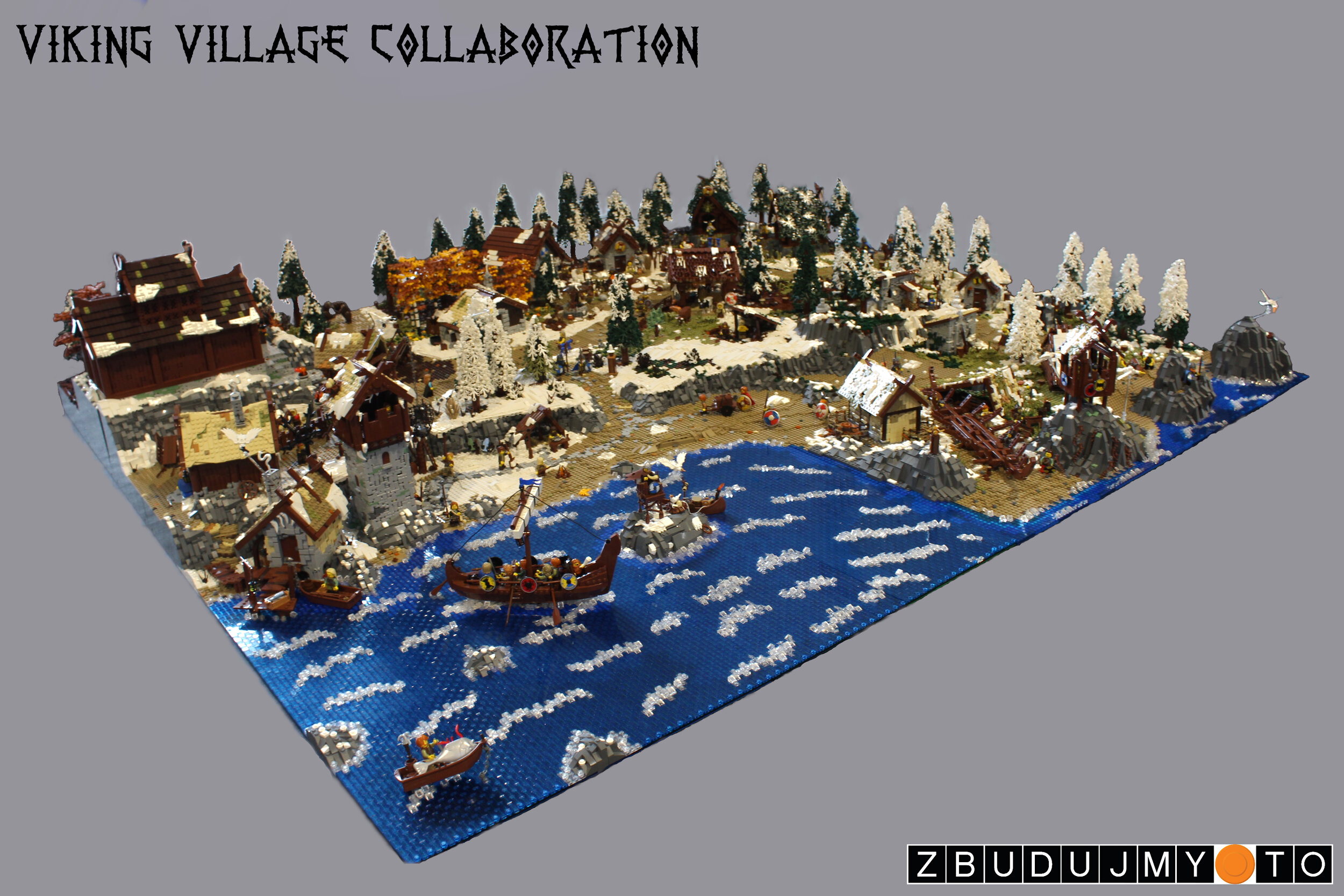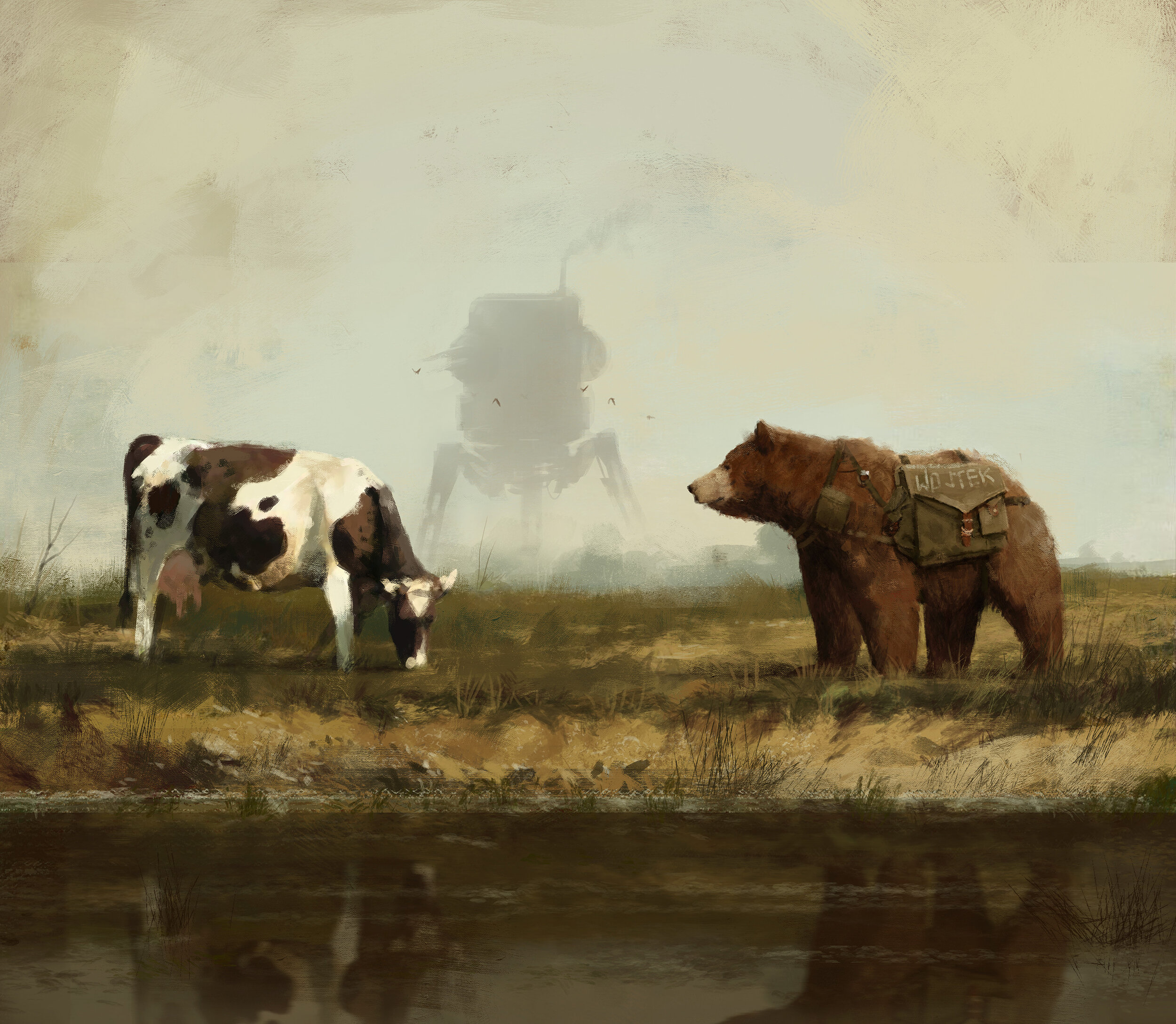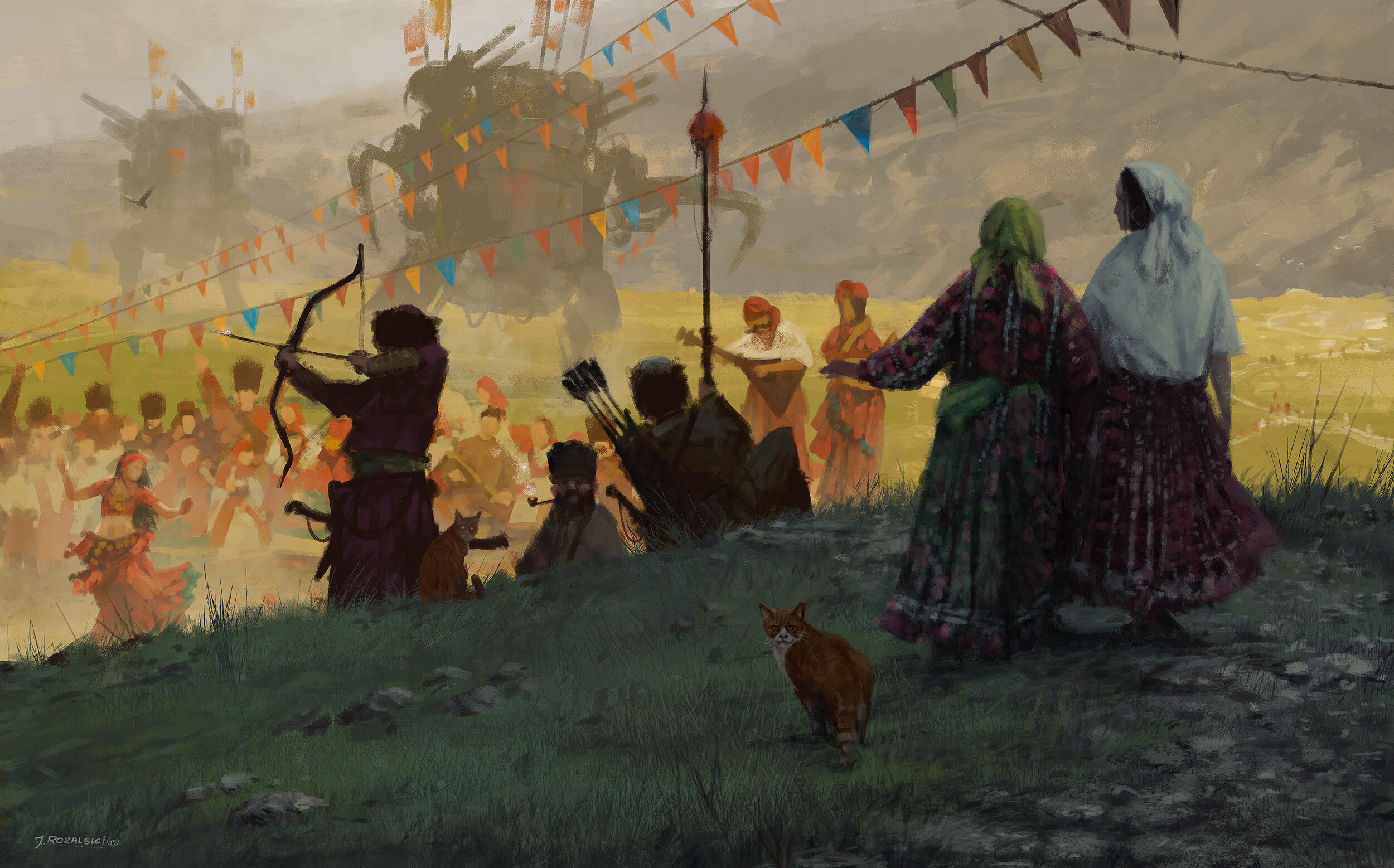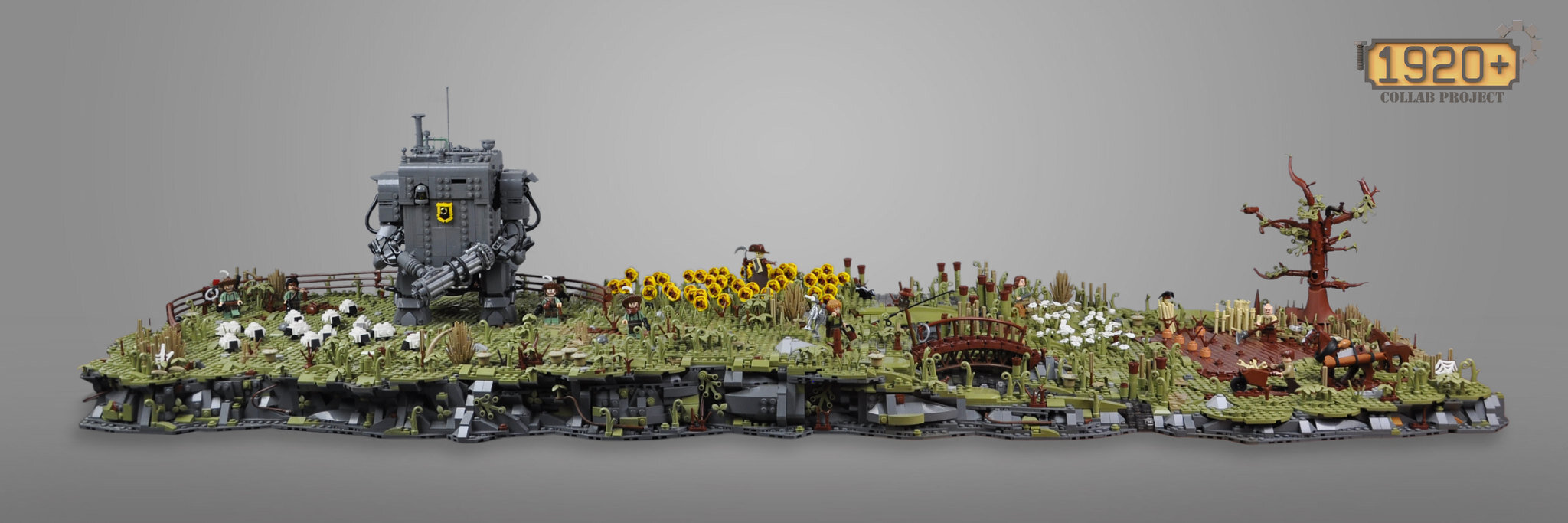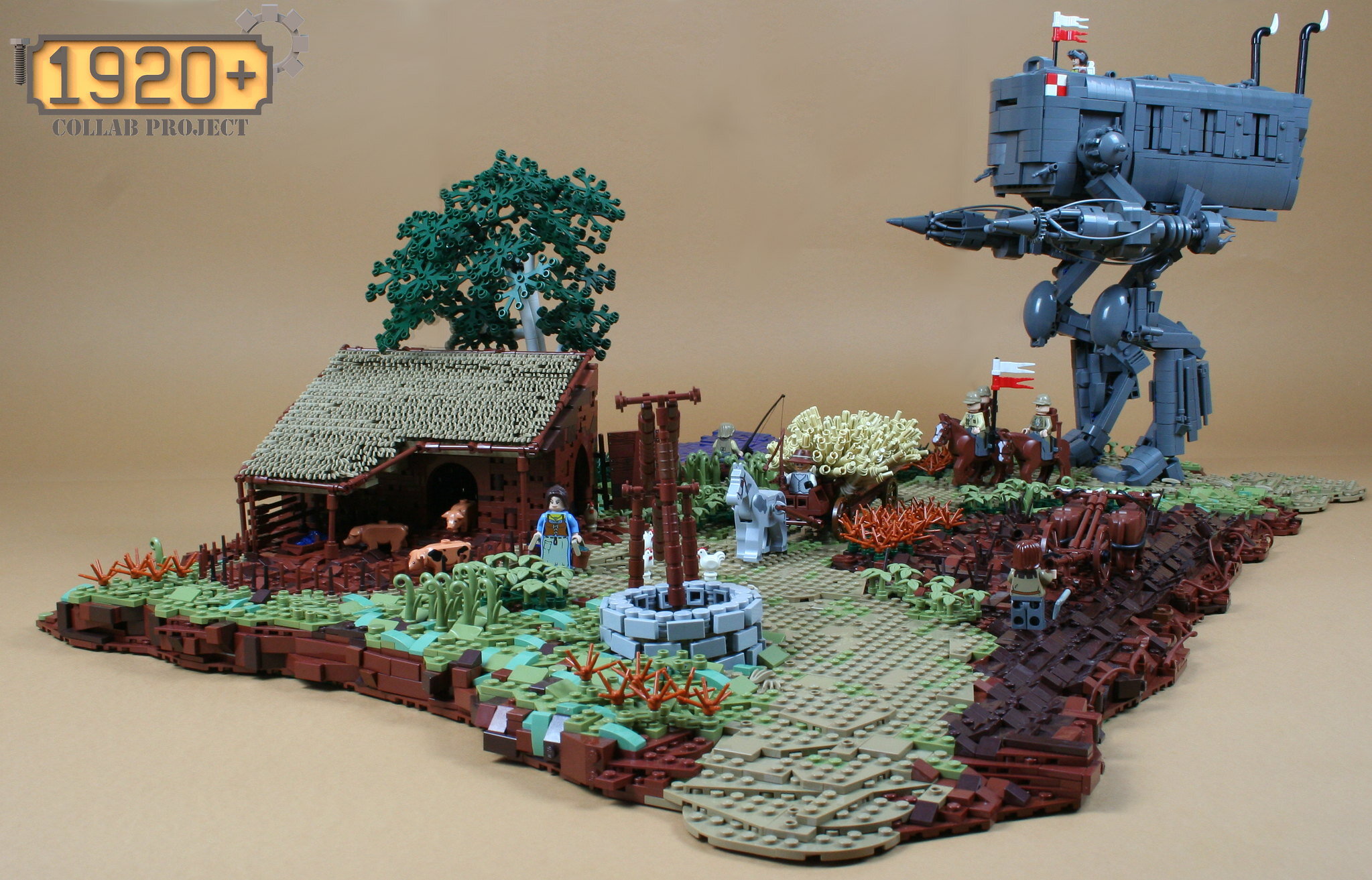The 1920+ Collab Making Jakub Różalski's Mech Artwork Materialize in LEGO
/Best of BrickNerd - Article originally published March 28, 2021.
One of the best parts of LEGO is creating new worlds—worlds that often come to life with well-thought backstories. The same goes for paintings, like the work of artist Jakub Różalski who creates alternate universes on canvas. His classic style of paintings often combines a rural landscape with mechs in the background. These mechs often look peaceful but you can feel the silent threat of the machines in the distance. His creative work has been used for the board game Scythe and the recent real-time strategy game Iron Harvest.
Recently, members from the Polish LUG Zbudujmy To were inspired by Różalski’s work and decided to use it as the inspiration behind a fantastic online collab. Mihal, one of the builders in the collab takes us through some of the progress.
Learning Some History About 1920+
Marco: Thanks for chatting with us today! To begin, how did you all start the collab?
Mihal: I suggested this collab theme at our LUG forum last September. I think the PC game premiere was a thing that inspired me to do that. I thought that the 1920+ universe would become more popular thanks to that and I wanted to contribute to spreading it also in the LEGO community. Plenty of LUG members thought it’s a cool setting and it would be nice to build something in it, so getting contributors for the collab was quite easy. Some of them already had some ideas in their minds. CTR even asked if I had his place wiretapped because he had already started working on one of the mechs.
Marco: Have you worked together on other collabs before?
Mihal: Collabs are not a new thing for us. In 2019 we made #thewitchercollab, it was a set of MOCs inspired by Andrzej Sapkowski “Last Wish” book. It’s a collection of seven stories presenting various adventures of Geralt of Rivia (btw, the books came first before the show!) so each one of us built a scene from one story. It was really cool, you should definitely check it out.
Last year we also made a Viking Village Collab. It was a big diorama (56 baseplates) and most of the participants of the 1920+ collab also took part in that. Despite the size of it, we were trying to get as detailed as it is possible on that scale and I would say that we were successful. It’s filled with little scenes, minifigs hanging around or fulfilling their duties—there is plenty of livestock and wildlife and every stud feels well thought out.
I would also like to mention one older collab we did in 2017. It started with my “Lechistan Army” and turned into “Alternative Vienna Battle.” We made a bunch of units from three factions—allied Poland and Austria fighting the Ottoman Empire. At the battlefield next to Polish hussars, mercenary musketeers and Ottoman Janissaries fought mechs and other fantastic creatures. It was a classic “science versus magic” theme—European forces were using sci-fi technology and Ottoman had sorcery and beasts. The idea for XVIIth century soldiers fighting mechs was clearly inspired by Różalski’s art.
We’ve made plenty of other collaborations, as we are trying to build something new every year. I will just give you the titles and you can look them up: Medieval Tournament, XIXth Century Street, History of Poland, a diorama of Zbudujcowo City, railroad diorama, Grunwald Battle, and many more that were built by my LUG members before I joined.
Marco: Were there more members familiar with the artwork, the Game Scythe, or the Iron harvest Game?
Mihal: Most of us were familiar with Jakub Różalski’s art. He is quite popular in Poland. One company even used to sell T-shirts with his pictures. Some of my LUGmates are big fans of board games and have played “Scythe.” I was always terrified by the size of its box, the number of pieces in it, and the rules that I would have to learn to play, so I have never played it myself.
Marco: Did most of you have a preference for a faction or mech? If so how did you choose?
Mihal: I would say that the “rule of cool” was the main factor while choosing the mech to build. There was no fighting for mechs or factions, we just started doing research using Różalski’s artwork and materials from “Iron Harvest.” And the “first come, first served” rule was applied. Most of the mechs that we built are from the Polania Republic but I’ve got no idea why (wink, wink). In some cases size of the mech was a limitation. It would have been nice to have some more big mechs included like the “Tur.” But it is huge and would have needed a gigantic diorama to stand on.
[A few examples of the work of artist Jakub Różalski from his 1920+ series.]
Marco: Is there a reason why you depicted the mechs in separate scenes rather than one gigantic fight as they go toe to toe?
Mihal: From the beginning, the idea was to create separate scenes. This style of the collab is much easier than making a huge diorama and it enables builders to create different landscapes (winter scene, autumn scene, etc.). It also gives builders plenty of freedom by not forcing them to keep to one style—everyone may build independently and in their own style.
What’s even more important, when you take a look at paintings by Różalski you will notice that mechs usually are not fighting. They are passing by the village and villagers don’t even care, sometimes they seem to be so focused on their duties and work that they don’t even notice a giant mech walking next to them. Very often the battle is somewhere in the background and we see some farmers working in the fields in the foreground.
Marco: Was the logo for the collab designed by one of you?
Mihal: The collab logo was designed and built by Goldsun in LDD. He is also the builder of Brunhilda—a big Saxonian AT-AT style walker. He shared some brick-sketches of the logo to get feedback from us and finally came up with a version you may see in our pictures.
Marco: Can we expect more 1920+ MOCs in the future?
Mihal: It’s highly probable that some of us will return to that setting. It’s too cool not to take another try. Some of us already choose another Różalski’s painting to turn into a LEGO version, so keep a look out!
Marco: About your own contribution, how long did it take you to build? And how did you progress throughout the model?
Mihal: I started with the “Smialy” model and that took me two weeks to build. Then I started building the terrain. It is hard to say how long it took because I had to order plenty of parts on BrickLink and wait for them to arrive. I did several other things in the meantime, like building some Mandalorian and Cyberpunk MOCs. The build started by imitating one of Różalski’s paintings but I decided to add some small river and a shrine to make it more interesting. With the river, I also thought it would be cool to include a watermill.
Marco: Do you sketch out your models first or do you build them digitally?
Mihal: I usually don’t build digitally. It’s easier for me to try new ideas with real bricks. But I have some sketches drawn by my girlfriend. I talked with her about the build and she really enjoyed it and wanted to help. And sketches are very helpful.
Marco: What do you like most about your MOC?
Mihal: Hard to say what’s my favorite part of the build. I really like how it all turned out, as well as the fact that I was able to put so many little details and scenes in there. Some of that hidden detail is as simple as a cat hunting, a bird hiding, and the colorful bunting at the shrine which is very similar to the ornaments that still can be spotted in the countryside in Poland.
I really like how the water turned out, I had to order royal blue plates to make that depth transition. The effect was worth it. I think the most tricky part of the build was the gable. The roof is always the most difficult part for me to build. I was kind of surprised how nicely LEGO geometry works, and when I put on that final piece, a brown triangular road sign, I honestly didn’t expect it would cover the hole 100% but it did!
Meandering Amidst Mechs
With the context of the collab more understood, let’s get a closer look at the other mechs.
Pz. Kpfm. IV “Vielfraß” by CTR Bartosz
This is a great LEGO depiction of the feel of Różalski’s paintings. You can see farmers just doing their daily job, living day by day along with the Vielfraß mech just standing there among the sheep who are clearly unaware of the devastating power the machine could cause and shear them out of existence. The machine looks menacing and CTR used some nice techniques, especially on the weapon, with a nice mix of tires, whips and tubes to depict the wiring. The thing that stands out most is the shield sigil, which is completely brick-built.
PZM 9 “Mocny” by Maciej Ramlo
Again, the animals don’t mind these dangerous machines—here the chickens just go about their business. The mech itself is sturdy with lethal machine guns on each side. Tracks are cleverly used as an ammo belt and the small shrine completes the scene. What stands out the most, though, are the almost spider-like legs of the mech crawling across the landscape.
Sunday Ride by Fajne Klocki
This water strider-like mech seems perfect for a relaxing ride. The color palette of oranges and olive green conveys the enjoyment of autumn vibes in nature. The legs are made up of small parts like the lightsaber hilt which make it perfect for traversing mountainous terrain.
The Shepard by Bartek Jost
Not all mechs are used to cause destruction. This shepherd is just calmly smoking his pipe—a clever use of the magic wand element—while having a perfect view to guard his sheep (which are little, adorable builds since LEGO hasn’t made any System sheep). The brown stud shooters as chopped trees in the background are also fun. But more importantly, this model shows that being part of a collab can also be achieved no matter the size!
Brunhilda by Grzegorz Ludwiczek
Brunhilda is obviously a force to be reckoned with—you could almost say it is the 1920+ version of an AT-AT Walker from Star Wars! What stands out most to me in this part of the collab isn’t the mech as much as all the small details—like the scared horses and the broken mech being reclaimed by nature. These brick-built details really make the scene come to life.
Saxon Wolves by So Sirius
A walking turret on sturdy legs, this mech has seen its share of battle if you look at the different colors used to show age. The tan wedge seems to be a part of renewed armor and the use of brown makes some of the parts seem rusty.
PZM-2 “Husar” by Lukasz Mackowiak
One of the largest mechs, Husar looks menacing with its Tesla coil-like arms. What really steals the show here for me though, is its representation of the source material. What’s happening on the farm is the most important part. And it gets a lot of detail, like the roof completely made out of claws which give at a straw-like effect.
PZM-05 “Straznik” by Mateusz Waldowski
Straznik is a clean, lean machine! This might be my favorite because it’s one of the most recognizable from the series as it shows Anna accompanied by her bear, Wojtek. But it could also be the placement of the mech, just slightly angled that makes the scene very dynamic. I feel like it’s really crawling through the forest.
To finish up, I guess the best praise of this collab comes from the artist Jakub Różalski himself who got word of the project. He posted a summary of the collab along with some kind words on his Instagram: “#1920CollabProject fan art project is so amazing that I have no words!”
I suppose if you can make an artist go speechless with your LEGO interpretation of his work, you can call that one more successful collab from Zbudujmy To. I personally look forward to the next one!
What other artists would inspire a fun LEGO collab? Let us know in the comments below.
Do you want to help BrickNerd continue publishing articles like this one? Become a top patron like Charlie Stephens, Marc & Liz Puleo, Paige Mueller, Rob Klingberg from Brickstuff, John & Joshua Hanlon from Beyond the Brick, Megan Lum, Andy Price, John A. and Lukas Kurth from StoneWars to show your support, get early access, exclusive swag and more.



